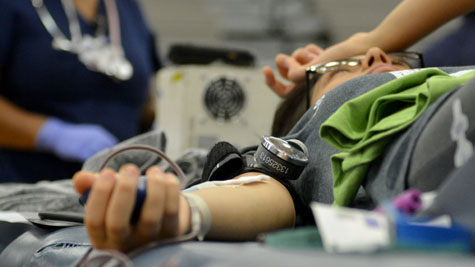HOSA blood drive: Not just donating blood

HOSA hosts a blood drive each year through the Gulf Coast Regional Blood Center.
The annual Health Occupations Student of America (HOSA) blood drive was held on Sept. 24, participants donated 162 blood products, which will save 486 lives.
Though the process to donate blood is long, junior Dustin Cunningham said that the end results are worth it.
“They take you behind a screen, and ask a series of questions to ensure that you are healthy and to verify your age and weight,” Cunningham said. “They will taking your blood pressure and prick your finger to check that your iron levels are high enough. Then they will sit you down in a chair and start the IV. Afterwards, they will give you something to increase your sugar levels, and send you back to class.”
The Gulf Coast Regional Blood Center collected the blood and sent it to hospitals throughout the gulf region of Texas. The donated blood will be used in three ways.
“Red blood cells can be collected and used on accident victims, surgical patients and patients that are anemic,” HOSA sponsor Joan Mooney said. “Platelets can be used on patients with Leukemia and other cancers. Plasma can be given to burn victims and patients in shock.”
HOSA’s objective is to encourage students to enter the health care field; and according to Mooney, the blood drive gives members a chance to improve health care skills, necessary to the profession.
“Participating in the blood drive is a way to have an active part in improving the health of patients in the present,” said Mooney. “It provides leadership opportunities to handle the logistics of the drive—the organization of the paperwork, moving donors through the processing areas and monitoring the donors afterwards for any untoward reactions. It provides an example of how important it is to be a volunteer in the community.”
Senior Madison Troxler said it was a great opportunity for students not in HOSA to participate as well.
“I was interested in helping and this was an easy and quick way to do so,” Troxler said. “It gets people involved in their communities and hopefully encourages them to continue donating and saving lives.”


